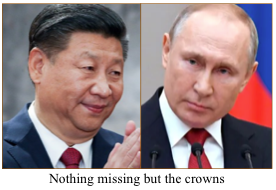The French proverb plus ça change, plus c’est la même chose (the more things change, the more they stay the same) most aptly describes what has been happening at the pinnacle of government in China and Russia.
Two years ago, the Chinese Communist Party, completely dominated by its 64-year-old president Xi Jinping, would drop term limits on the presidency. After Mao’s lengthy dictatorship, the Party moved away from one-man rule toward a consensus system where power was shared by a handful of high-ranking Party officials. This worked until the ascent of Xi, who was declared “core leader” as state media (Read more…) sung his praises. He has consolidated power and now with the end of term limits he becomes, in effect, president-for-life. A new emperor.
In China’s vast neighbour to the north, we have recently seen similar developments, perhaps inspired by Xi. The Russian parliament is proposing constitutional changes that could leave Vladimir Putin in power until 2036. He is currently required to step down in 2024 when his most recent term ends. If, as is highly likely given his grip on the nation, the constitutional court gives its blessing to the changes and they are backed in an April referendum, he could be president until he’s 83, essentially for life. A new tsar.
When the former communist regimes in these two giants came to an end, with the death of Mao in China and the collapse of the Soviet Union under its own dead weight, some of us had great hopes that democracy might root itself in both. Instead it seems as if the tumultuous revolutions that birthed communism, and the carnage and oppression they engendered, ultimately changed nothing. Just passing chapters to be endured. They were ruled by dictators before, they are ruled by dictators now, and they were ruled by dictators in between. Plus ça change.

